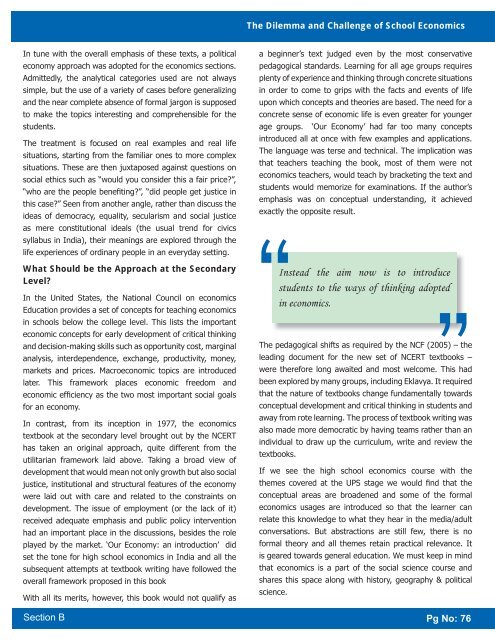Indesign Pagesnew.indd - Azim Premji Foundation
Indesign Pagesnew.indd - Azim Premji Foundation
Indesign Pagesnew.indd - Azim Premji Foundation
Create successful ePaper yourself
Turn your PDF publications into a flip-book with our unique Google optimized e-Paper software.
In tune with the overall emphasis of these texts, a political<br />
economy approach was adopted for the economics sections.<br />
Admittedly, the analytical categories used are not always<br />
simple, but the use of a variety of cases before generalizing<br />
and the near complete absence of formal jargon is supposed<br />
to make the topics interesting and comprehensible for the<br />
students.<br />
The treatment is focused on real examples and real life<br />
situations, starting from the familiar ones to more complex<br />
situations. These are then juxtaposed against questions on<br />
social ethics such as “would you consider this a fair price?”,<br />
“who are the people benefi ting?”, “did people get justice in<br />
this case?” Seen from another angle, rather than discuss the<br />
ideas of democracy, equality, secularism and social justice<br />
as mere constitutional ideals (the usual trend for civics<br />
syllabus in India), their meanings are explored through the<br />
life experiences of ordinary people in an everyday setting.<br />
What Should be the Approach at the Secondary<br />
Level?<br />
In the United States, the National Council on economics<br />
Education provides a set of concepts for teaching economics<br />
in schools below the college level. This lists the important<br />
economic concepts for early development of critical thinking<br />
and decision-making skills such as opportunity cost, marginal<br />
analysis, interdependence, exchange, productivity, money,<br />
markets and prices. Macroeconomic topics are introduced<br />
later. This framework places economic freedom and<br />
economic effi ciency as the two most important social goals<br />
for an economy.<br />
In contrast, from its inception in 1977, the economics<br />
textbook at the secondary level brought out by the NCERT<br />
has taken an original approach, quite different from the<br />
utilitarian framework laid above. Taking a broad view of<br />
development that would mean not only growth but also social<br />
justice, institutional and structural features of the economy<br />
were laid out with care and related to the constraints on<br />
development. The issue of employment (or the lack of it)<br />
received adequate emphasis and public policy intervention<br />
had an important place in the discussions, besides the role<br />
played by the market. ‘Our Economy: an introduction’ did<br />
set the tone for high school economics in India and all the<br />
subsequent attempts at textbook writing have followed the<br />
overall framework proposed in this book<br />
With all its merits, however, this book would not qualify as<br />
Section B<br />
The Dilemma and Challenge of School Economics<br />
a beginner’s text judged even by the most conservative<br />
pedagogical standards. Learning for all age groups requires<br />
plenty of experience and thinking through concrete situations<br />
in order to come to grips with the facts and events of life<br />
upon which concepts and theories are based. The need for a<br />
concrete sense of economic life is even greater for younger<br />
age groups. ‘Our Economy’ had far too many concepts<br />
introduced all at once with few examples and applications.<br />
The language was terse and technical. The implication was<br />
that teachers teaching the book, most of them were not<br />
economics teachers, would teach by bracketing the text and<br />
students would memorize for examinations. If the author’s<br />
emphasis was on conceptual understanding, it achieved<br />
exactly the opposite result.<br />
Instead the aim now is to introduce<br />
students to the ways of thinking adopted<br />
in economics.<br />
The pedagogical shifts as required by the NCF (2005) – the<br />
leading document for the new set of NCERT textbooks –<br />
were therefore long awaited and most welcome. This had<br />
been explored by many groups, including Eklavya. It required<br />
that the nature of textbooks change fundamentally towards<br />
conceptual development and critical thinking in students and<br />
away from rote learning. The process of textbook writing was<br />
also made more democratic by having teams rather than an<br />
individual to draw up the curriculum, write and review the<br />
textbooks.<br />
If we see the high school economics course with the<br />
themes covered at the UPS stage we would fi nd that the<br />
conceptual areas are broadened and some of the formal<br />
economics usages are introduced so that the learner can<br />
relate this knowledge to what they hear in the media/adult<br />
conversations. But abstractions are still few, there is no<br />
formal theory and all themes retain practical relevance. It<br />
is geared towards general education. We must keep in mind<br />
that economics is a part of the social science course and<br />
shares this space along with history, geography & political<br />
science.<br />
Pg No: 76

















